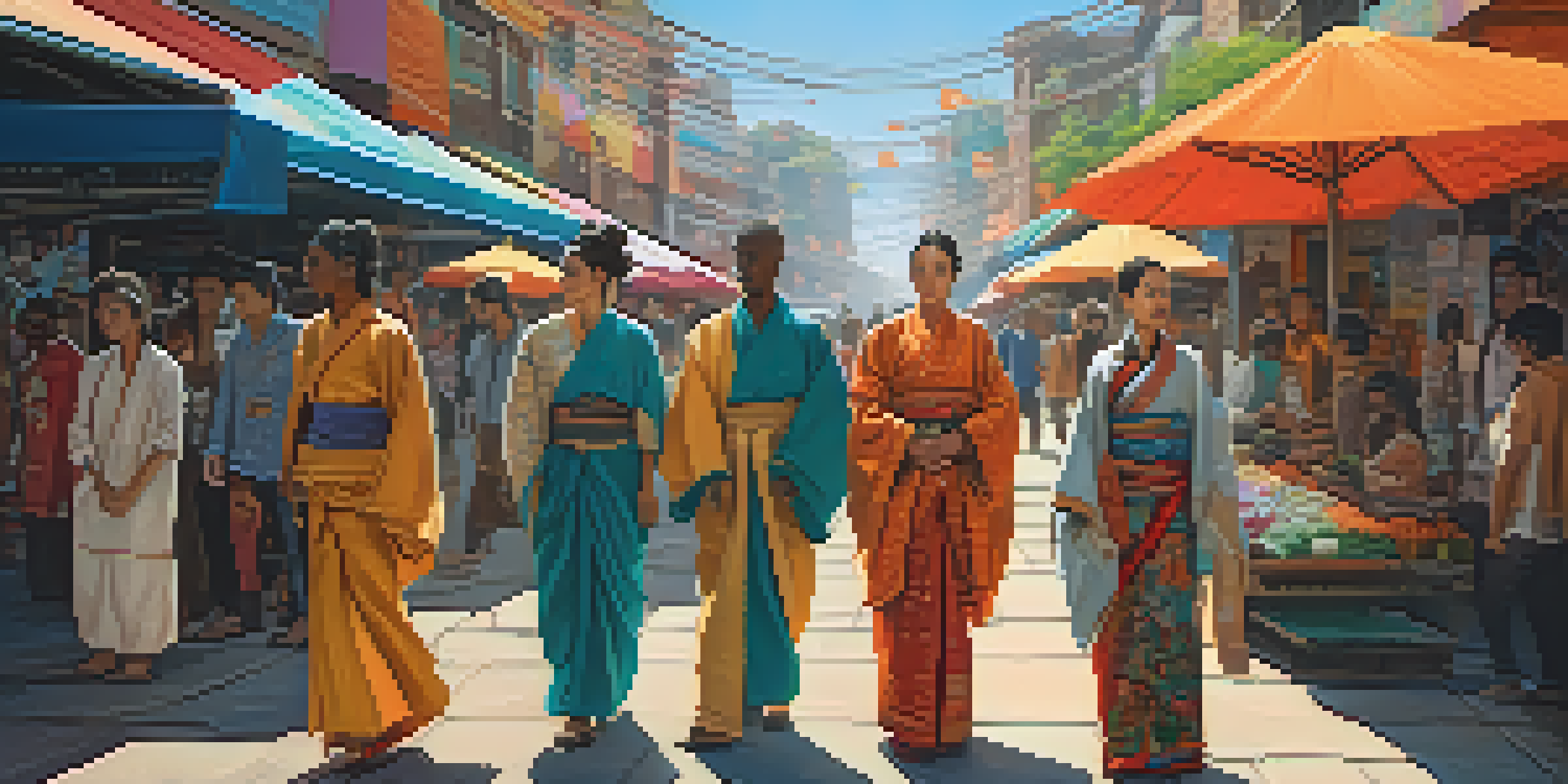Fashion as a Medium for Personal Storytelling and Expression

Understanding Fashion as a Form of Expression
Fashion is more than just clothing; it’s a powerful means of self-expression. Every choice we make in what we wear can convey messages about our personality, beliefs, and emotions. For instance, a bright yellow dress might express joy and optimism, while a classic black outfit could signify elegance or sophistication.
Fashion is the armor to survive the reality of everyday life.
Moreover, fashion allows individuals to showcase their creativity. People can mix and match styles, colors, and patterns that resonate with their unique experiences. This personal touch transforms clothing into a storytelling medium, where each outfit narrates a different aspect of who we are.
In essence, fashion serves as a visual language, enabling us to communicate without uttering a single word. It encourages us to embrace our individuality and, in doing so, creates a rich tapestry of diverse stories woven through our wardrobes.
Cultural Influences on Fashion Choices
Our cultural backgrounds significantly shape our fashion choices and storytelling. Different cultures bring unique aesthetics, textiles, and traditions that influence how we dress. For instance, traditional garments like the kimono or sari tell stories of heritage and history, connecting wearers to their roots.

As globalization increases, the blending of cultures in fashion becomes more apparent. People might adopt elements from various styles to create a hybrid look that reflects their multicultural identity. This fusion not only showcases diversity but also highlights the personal narratives that emerge from intersecting cultures.
Fashion as Self-Expression
Fashion serves as a powerful means of self-expression, allowing individuals to convey their personality, beliefs, and emotions through their clothing choices.
Ultimately, clothing can serve as a bridge between cultures, fostering understanding and appreciation. By wearing fashion that draws from various influences, individuals can express their multifaceted identities and tell stories that resonate on both personal and communal levels.
Fashion as a Reflection of Personal Experiences
Our life experiences often shape our fashion choices, making them deeply personal. For example, someone who has overcome challenges may choose bold, statement pieces as a symbol of resilience. Each article of clothing can evoke memories and emotions tied to significant moments in our lives.
Style is a way to say who you are without having to speak.
Additionally, fashion can act as a form of therapy. Many individuals use clothing to cope with emotions, such as wearing cozy loungewear during tough times for comfort. This connection between clothing and feelings can create a profound narrative that shares our journey with others.
Thus, every outfit can tell a story of triumph, struggle, and growth. By being mindful of what we wear and why we wear it, we can craft a narrative that resonates with our personal experiences and invites others to understand our journey.
The Role of Fashion Icons in Storytelling
Fashion icons play a crucial role in shaping narratives around personal expression. Celebrities and influencers often use their platforms to express individuality, inspiring others to do the same. For instance, when a public figure wears a particular style, it can spark trends that encourage fans to explore their own fashion stories.
Moreover, fashion icons often embody specific values or movements, using their influence to advocate for social change. By donning sustainable fashion or supporting local artisans, they tell a story of responsibility and awareness that resonates with their audience.
Cultural Influences on Fashion
Our cultural backgrounds significantly shape our fashion choices, blending unique aesthetics and traditions to create personal narratives.
These narratives not only inspire but also create a sense of community. Fans and followers often connect through shared fashion choices, forming relationships based on mutual appreciation for the stories they tell through their clothing.
Sustainable Fashion and Ethical Storytelling
The rise of sustainable fashion has added a new layer to storytelling in fashion. As consumers become more aware of the environmental impact of their choices, many are opting for brands that prioritize sustainability. This shift allows individuals to tell a story of responsibility and care for the planet through their fashion choices.
Ethical fashion brands often share their narratives of how garments are made, from sourcing materials to fair labor practices. This transparency enables consumers to connect with the story behind their clothing, reinforcing their values and beliefs.
In this way, every sustainable purchase becomes part of a larger story about conscious consumerism. By choosing to invest in ethically made fashion, individuals not only express their style but also contribute to a narrative of positive change.
Fashion and Social Movements: A Story of Change
Fashion has long been intertwined with social movements, acting as a powerful medium for change. Throughout history, clothing has been used to make statements, from the suffragettes donning white to symbolize purity to modern-day movements advocating for equality. Each garment worn in these contexts tells a story of struggle and hope.
Additionally, fashion can be a way to challenge societal norms. By wearing clothing that defies traditional gender roles or societal expectations, individuals can assert their identities and beliefs. This act of rebellion not only expresses personal stories but also encourages others to reflect on their own narratives.
Sustainable Fashion's Impact
The rise of sustainable fashion enables consumers to tell a story of responsibility and care for the planet through their ethical clothing choices.
Ultimately, the intersection of fashion and social movements highlights the role of clothing as a catalyst for conversation and change. Every outfit has the potential to spark dialogue and connect individuals to broader social issues, weaving personal stories into the fabric of collective movements.
The Future of Fashion Storytelling
As we look to the future, the role of fashion as a storytelling medium will continue to evolve. With advancements in technology, such as virtual reality and augmented reality, the way we experience fashion will change dramatically. Imagine stepping into a digital wardrobe where each piece narrates its own story, enhancing our understanding of fashion as an art form.
Moreover, the increasing emphasis on inclusivity means that diverse voices will shape future fashion narratives. As more individuals share their stories, the industry will reflect a broader spectrum of experiences, enriching the tapestry of fashion.

In conclusion, fashion will remain a dynamic canvas for personal storytelling and expression. By embracing innovation and inclusivity, the future of fashion promises to be a vibrant and diverse narrative that reflects the complexities of our identities.